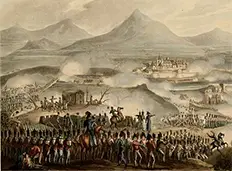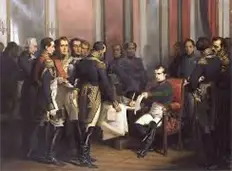The War of the Sixth Coalition
Part 2: Allied Victory When the fighting resumed, with Austria installed against France, the French won again, at Dresden. However, the Allied forces scored victories of their own–at Großbeeren, Katzbach, Dennewitz, and (most significantly) Kulm. Many at this time and since have referred to the War of the Sixth Coalition Leaders of the major powers met in Frankfurt; the terms that they offered to Napoleon became known as the Frankfurt Proposals. Allied leaders demanded that France resume its "natural boundaries," meaning giving up all territory won in Germany, Italy, Poland, and Spain. Even though the proposal allowed France to keep control of Belgium, Savoy, and the Rhineland and allowed Bonaparte to keep his imperial title and throne, he refused the offer and the war continued. Just a few weeks later, on November 9, 1813, a joint Portuguese-U.K. force, having scored a knockout blow against French troops in Spain at the Battle of Vitoria in June, crossed over the Pyrenees and invaded France. Allied troops were soon invading France from the north. Once Allied forces were within France's traditional borders, the end came rather quickly. Even the vaunted Napoleon could not compete with overwhelming numbers of men and weapons arrayed against him and his beleaguered, dispirited men. After a brief series of French victories in the Six Days' campaign, Allied troops entered Paris on March 30, 1814. The Allied force that had invaded from the south seized Toulouse after a four-day battle. On April 11, Bonaparte abdicated the throne but only after his marshals mutinied and demanded that he do so, refusing to follow any more of his orders. On that day, France signed a treaty with all countries but the U.K. That pact, the Treaty of Fontainebleau, ended the war except for the fighting that was still going on in southern France.
The Treaty of Paris, signed on May 30, 1814, by France and the U.K., officially ended the War of the Sixth Coalition. Following on from that was the Congress of Vienna, which redrew the map of Europe. Bonaparte was exiled to the island of Elba. The new leader of France was King Louis XVIII, who had ordered the last surrender, that of Davout in Hamburg, on May 27. Of the Coalition's total force of 1,070,000, losses numbered nearly half that, with 391,000 killed or wounded in action and 135,000 captured or missing. Of the French Empire's total force of 850,000, losses numbered 668,000, with 329,000 killed or wounded in action and 245,000 captured or missing. First page > A Grand Alliance > Page 1, 2 |
|
Social Studies for Kids
copyright 2002–2024
David White



 as the War of German Liberation. A significant part of that liberation came at the
as the War of German Liberation. A significant part of that liberation came at the 



